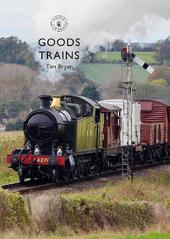
|
Goods Trains
Paperback / softback
Main Details
| Title |
Goods Trains
|
| Authors and Contributors |
By (author) Tim Bryan
|
| Series | Shire Library |
|---|
| Physical Properties |
| Format:Paperback / softback | | Pages:64 | | Dimensions(mm): Height 210,Width 149 |
|
| Category/Genre | History
Industrialisation and industrial history
Transport
Trains and railways |
|---|
| ISBN/Barcode |
9781784423995
|
| Classifications | Dewey:385.240941 |
|---|
| Audience | |
|---|
| Illustrations |
Fully illustrated throughout
|
|
Publishing Details |
| Publisher |
Bloomsbury Publishing PLC
|
| Imprint |
Shire Publications
|
| Publication Date |
28 May 2020 |
| Publication Country |
United Kingdom
|
Description
Have you ever watched wagon after wagon of a goods train thunder past and wondered where it is heading, what it is carrying, and how it works its way between the passenger services? While goods services now tend to be shrouded in anonymity, in past times they were celebrated, prominently advertised, and in many cases were the raisons d'etre for a rail route. Throughout the nineteenth and much of the twentieth century, goods trains were the lifeblood of the nation, transporting precious raw materials, construction and industrial items, and fresh produce from coastal areas and farms into the centres of bustling cities. This informative illustrated history shows how rail freight has been carried since Victorian times, and how systems have been organized, from the train itself to the sidings, railway clearing houses, goods sheds and final destinations - whether villages, towns, cities, factories or docks. It also examines the basic rolling stock of these trains, from the humble coal wagon to today's hi-tech containers.
Author Biography
Tim Bryan worked as curator at the GWR and STEAM museums in Swindon for more than twenty years and is now Director of the Brunel Institute at the SS Great Britain in Bristol. He is the author of eighteen books on railway and heritage topics and has written six titles for Shire.
ReviewsA remarkably informative work of reference. * Journal of the Railway and Canal Historical Society *
|